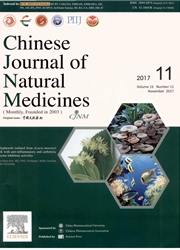

 中文摘要:
中文摘要:
目的:1)研究生脉散整方及三个不同部位:乙酸乙酯部位,正丁醇部位,水部位的抗氧化和抗炎活性;2)阐明生脉散及各不同极性部位发挥作用的物质基础。方法:用双向颈总动脉结扎诱导小鼠短暂前脑缺血再灌注模型来考察生脉散及各部位的活性。对脑组织病理损伤,血脑屏障通透性和一系列抗氧化和抗炎相关指标,包括:MDA,SOD,GPx,MPO,NO和TNF-α进行检测。用LC-MS检测了各部位的化合物组分。结果:在乙酸乙酯部位检测到18个木脂素类化合物,正丁醇部位检测到13个甾体皂苷和人参皂苷。生脉散能显著抑制脑缺血再灌注导致的脑组织损伤和脑组织内MPO的活性;生脉散整方在抗氧化和抗炎水平上对抗脑缺血的活性最强。乙酸乙酯部位的抗氧化活性强于其它两个部位,而正丁醇部位更能抑制NO和TNF-α的生成。结论:生脉散作为整体比三个部位有更强的抗脑缺血作用,可能是不同化合物群协同作用的结果。
 英文摘要:
英文摘要:
AIM: To investigate the antioxidant and anti-inflammatory effects of Shengmai San (SMS) and its ethyl acetate extract (SEa), n-butanol extract (SBu), and aqueous extract (SWe), and clarify the material base of SMS and the roles played by its fractions. METHODS: A mouse model of transient forehrain ischemia/reperfusion (I/R) by means of common carotid artery occlusion (CCAO) was used to investigate the effects of SMS and its three fractions. Histopathological damage, blood-brain barrier disruption, and anti- oxidant and inflammation-related parameters, including malondialdehyde (MDA), superoxide dismutase (SOD), glutathione peroxidase (GPx), myeloperoxidase (MPO), nitric oxide (NO), tumor necrosis factor-a (TNF-a) were measured. The chemical constituents of each fraction were identified by LC-MS. RESULTS: Eighteen lignans in SEa, and thirteen steroidal glycosides and ginsenosides in SBu were determined. SMS significantly inhibited I/R induced formation of histological injury and cerebral MPO activity. SMS showed the strongest antioxidant and anti-inflammatory effects against the l/R-caused injuries. SEa showed higher antioxidant activity than the other two fractions and SBu has a slightly stronger inhibition on the productions of NO and TNF-a. CONCLUSION: SMS as a whole had the most effective protection against cerebral IfR-caused injuries compared with its fractions, which inferred that it contains differ- ent groups of compounds that contribute together to its protective effect.
 同期刊论文项目
同期刊论文项目
 同项目期刊论文
同项目期刊论文
 Neuroprotective effects of Huang-Lian-Jie-Du-Decoction on ischemic stroke rats revealed by 1H NMR me
Neuroprotective effects of Huang-Lian-Jie-Du-Decoction on ischemic stroke rats revealed by 1H NMR me H-1 nuclear magnetic resonance-based metabolomics reveals sex-specific metabolic changes of gastrodi
H-1 nuclear magnetic resonance-based metabolomics reveals sex-specific metabolic changes of gastrodi NMR-based metabolomics approach to study the toxicity of lambda-cyhalothrin to goldfish (Carassius a
NMR-based metabolomics approach to study the toxicity of lambda-cyhalothrin to goldfish (Carassius a NMR-based metabolomics approach to study the chronic toxicity of crude ricin from castor bean kernel
NMR-based metabolomics approach to study the chronic toxicity of crude ricin from castor bean kernel NMR-based metabonomic study of Chinese medicine Gegen Qinlian Decoction as an effective treatment fo
NMR-based metabonomic study of Chinese medicine Gegen Qinlian Decoction as an effective treatment fo H-1 NMR-based metabolomics approach to evaluate the effect of Xue-Fu-Zhu-Yu decoction on hyperlipide
H-1 NMR-based metabolomics approach to evaluate the effect of Xue-Fu-Zhu-Yu decoction on hyperlipide Gender-specific metabolic responses in focal cerebral ischemia of rats and Huang-Lian-Jie-Du decocti
Gender-specific metabolic responses in focal cerebral ischemia of rats and Huang-Lian-Jie-Du decocti Cholestatic liver injury model of bile duct ligation and the protection of Huang-Lian-Jie-Du decocti
Cholestatic liver injury model of bile duct ligation and the protection of Huang-Lian-Jie-Du decocti Developmental toxicity and neurotoxicity of two matrine-type alkaloids, matrine and sophocarpine, in
Developmental toxicity and neurotoxicity of two matrine-type alkaloids, matrine and sophocarpine, in Toxic effects of chronic low-dose exposure of thioacetamide on rats based on NMR metabolic profiling
Toxic effects of chronic low-dose exposure of thioacetamide on rats based on NMR metabolic profiling 期刊信息
期刊信息
